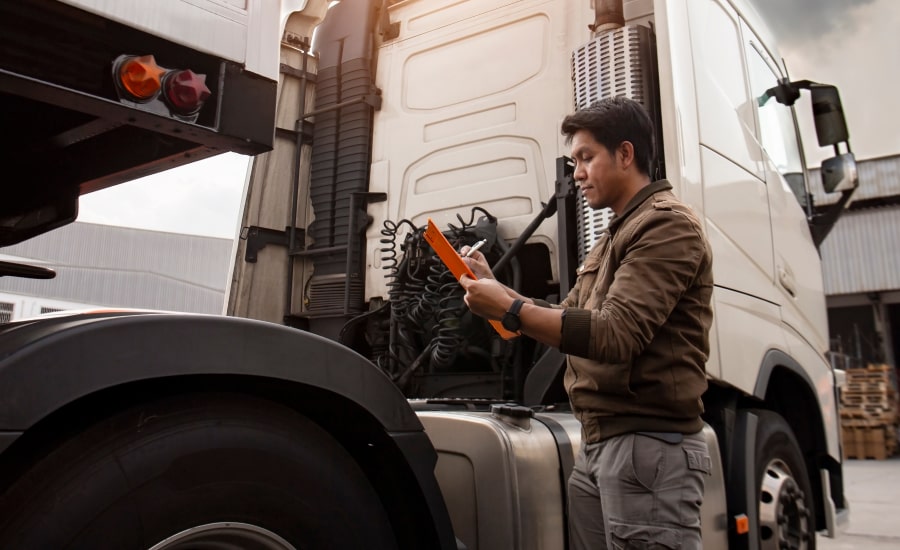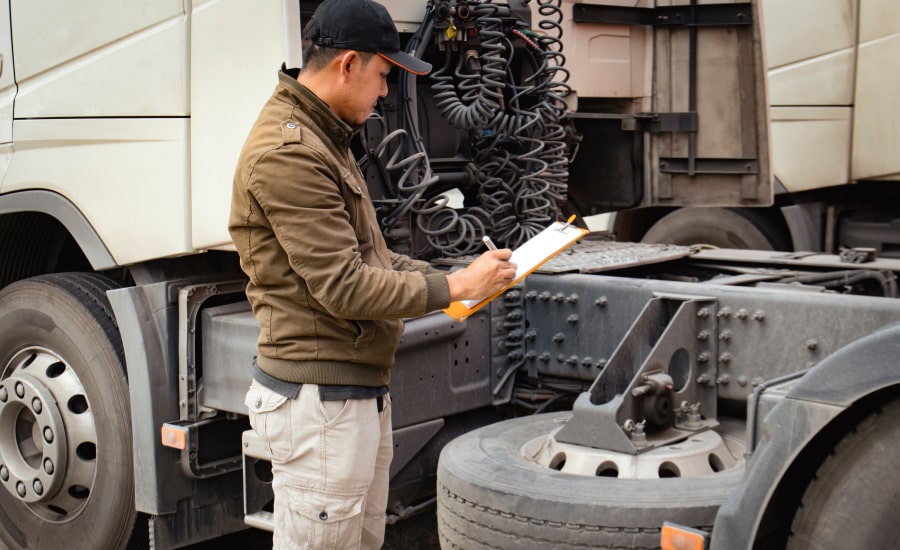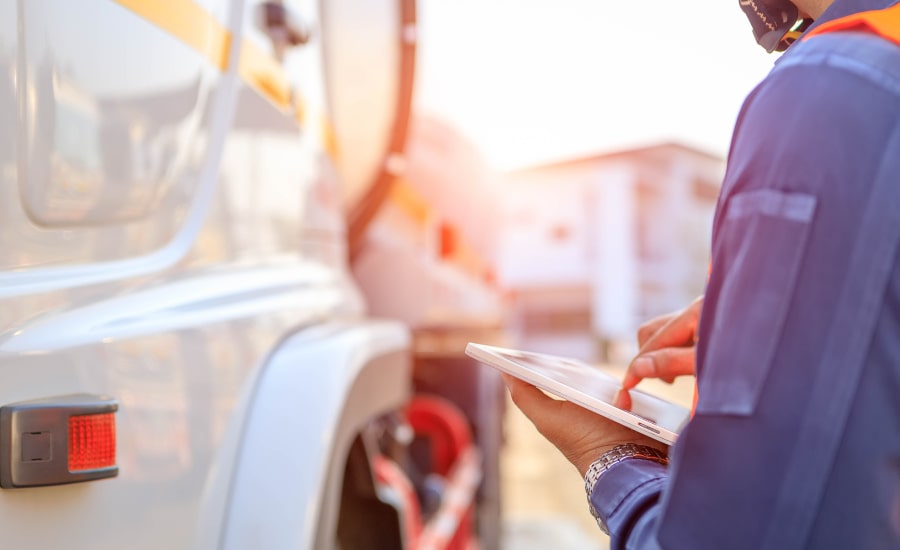
If you’re driving a commercial vehicle, you already know how important a pre-trip inspection is.
Required by the Department of Transportation, it’s probably one of the most frequent tasks you do on the job.
While it might seem boring or redundant, a pre-trip inspection is the only way to ensure your vehicle is safe for the trip.
We’ll share everything you need to know about a CDL pre-trip inspection checklist, from the benefits to what it should include.
We’ll also show you how to get rid of time-consuming paperwork and streamline the safety process with doForms!
Table of Contents
Digitize your pre-trip inspection checklists.
Try doForms for free!
What Is A CDL Pre-Trip Inspection Checklist?
A Commercial Drivers Licenses (CDL) pre-trip inspection checklist is a list of items that truck or bus drivers must check before a trip.
The purpose is to make sure the vehicle complies with safety regulations, reducing the risk of accidents and protecting the driver and other participants on the road.
A CDL pre-trip inspection checklist covers all parts of trucks, buses, and other commercial vehicles, including engines, brakes, tires, lights, and other systems.
A daily pre-trip inspection takes between 15 and 30 minutes to complete.
Benefits Of Pre-Trip Inspection Checklists
A thorough pre-trip inspection is required by both federal and state laws. Skipping an inspection can result in violations, vehicle downtime and accidents.
Pre-trip inspection checklists make sure nothing is left out. Plus, their use:
- Helps find technical issues before they turn into serious problems
- Prevents costly repairs and delays
- Reduces the chance of fines and violations
- Improve vehicle performance
- Improve your fleet reliability

Using a detailed checklist can help ensure nothing is missed during the pre-trip inspection
CDL Pre-Trip Inspection Checklist
A detailed checklist will help you inspect your commercial vehicle. Here’s what to include.
Front Suspension
- Shock absorber: Make sure there are no leaks, and that the rubber is not split or dry.
- Spring hanger and spring mount: Check for cracks and signs of breakage.
- U-bolts: Verify that all bolts are in place.
- Leaf springs: Check for cracks, shifts or breakage.
- Airbag: Make sure there are no missing mounting bolts, leaks or cuts.
Front Of Vehicle
- Gearbox and hoses: Check for leaks, cuts or splits. Secure the hoses on both ends.
- Pitman arm: Tighten all caste nuts and cotter pins.
- Upper and lower control arms and tie rod: Secure the tie rod and inspect it for signs of bending or cracking.
- Shaft/steering column: Check for indications of bending or breakage.
- Drag link: Look for rubber splits and verify that the rubber is greased.
Engine Compartment
- Power steering fluid, oil, and coolant: Check for leaks and verify fluid levels.
- Hoses: Inspect the hoses for cuts and splits. Secure them on both ends.
- Air compressor: Examine the air compressor for signs of breakage, cracks or leakage.
- Alternator: Make sure wires are connected properly.
- Water pump: Make sure the hoses are properly connected and there is no leakage.
- Belts: Confirm that the alternator, compressor and pump belts are securely mounted. Inspect them for cracks or wearing. Make sure the belt play is no more than 1/2″ to 3/4″.
Fuel Area And Driver Door
- Steps: Verify if they are mounted properly.
- Door and hinges: Make sure the hinges are intact and the door opens and closes. Inspect door seals for signs of wear and tear.
- Mirrors and bracket: Check hardware attachments and clean the mirrors.
- Fuel tank: Make sure the cap is tight and the seal is intact. Inspect the tank for signs of leakage.
Rear Of Vehicle
- Exhaust system: Check for leaks. Make sure the exhaust system is not loose.
- Steps and catwalk: Confirm that there are no loose objects and that the catwalk and steps are properly mounted.
- Mudflaps: Check if all mudflaps are in place and located at the right height.
- Drive shaft: Make sure the U-joints are free of debris and intact.
- Frame: Check for unauthorized welds and broken elements.
Coupling Area
- Electric lines: Check that all safety latches are in place and lines are not tangled or dragging on the catwalk.
- Air connector: Make sure there are no leaks, cuts or abrasions. Secure the connector on both ends.
- Fifth wheel platform: Check for cracks or breakage, illegal or unauthorized welds.
- King pin: Make sure the king pin is mounted and secure, with no cracks or bending.
- Locking jaw: Ensure it is fully locked around the king pin.
- Mounting bolts: Examine if all bolts are tightened.
- Skid plate: Make sure it is properly greased.
- Glad hands: Check for cracks or signs of rotting.
- Release arm: Ensure it is in a fully locked position.
- Apron: Make sure there are no cracks or signs of bending.
- Sliding 5th wheel locking pins: Ensure they are fully locked.
Lights & Reflectors
Check all lights on the front, rear, and both sides of your vehicle:
- Turn signals
- High and low beams
- Brake lights
- License plate
- Hazards/4-way flashers
- Reflector tapes
Air Brake Test & In-Cab Area Inspection
- Seat belt: Make sure it latches properly and has no signs of wear and tear.
- Lighting indicators: Check if lighting indicators are working.
- Oil pressure indicator: Verify it works in the required operating range.
- Water temperature gauge: Verify it functions in the required operating range.
- Air pressure gauges: Make sure air pressure gauges are working.
- Voltmeter/ammeter: Make sure it charges between 13 and 14 volts.
- Mirrors: Confirm they are properly adjusted, without cracks or obstructions to hinder your vision.
- Windshield: Make sure there are no cracks and debris.
- Windshield wipers and washers: Check for proper functioning.
- Horns: Make sure the horns are working.
- Heater/defroster: Switch it on to check if it’s functioning.
- Safety/emergency equipment: Ensure you have three red reflective triangles, a fully charged and secured fire extinguisher and spare electrical fuses.
- Steering wheel: Must be secured to the steering column.
- Foot pedals: Confirm there is no debris, obstructions or grease.
- Hydraulic brake: Pump the brake pedal. Apply pressure and hold it for five seconds to ensure it is not moving.
- Air brake: Check for warning lights and buzzers, valve pop-outs and applied pressure.
- Parking brake: For the trailer, set the trailer brake and release the tractor brake, then put the truck in low gear and tug. For the tractor, set the tractor brake and release the trailer brake. Use low gear and tug.
- Service brake: Release both the trailer and tractor brakes. Drive three to five miles per hour. Use the service brake and stop the vehicle. Make sure the steering does not move to the left or right.
Brake System (For Both Tractor & Trailer)
- Brake hose: Examine for cuts, splits and leaking air.
- Slack adjuster and push rod: Release the brakes and pull to make sure the push rod stays at a 90° angle to the brake chamber and doesn’t have more than 1” of play.
- Brake drum: Examine for excessive heating.
- Brake pads/brake lining: Make sure brake pads and brake lining are free of debris and oil.
Wheel System (For Both Tractor & Trailer)
- Wheel rims: Check for unauthorized welds.
- Steer tires: Make sure there are no bulges and cuts on the sidewalls and the tread. Confirm the tread depth is not less than 4/32”. Use an air gauge to check the tires’ inflation levels.
- Drive tires: Make sure there are no cuts and bulges. Ensure the tread depth is not less than 2/32”. Check the inflation levels with an air gauge.
- Valve stem: Check if the metal cap is in place and there is no air leakage.
- Lug nuts: Ensure lug nuts have no cracks or rust.
- Hub seal/axle seal: Examine for leaks.
Trailer
- Frame and cross members: Check the frame and cross members for cracks, bending or breakage. Inspect the header board for damage, holes or missing rivets.
- Landing gear: Secure the cradle handle. Inspect for signs of damage.
- Doors and hinges: Make sure doors open, close and latch properly.
- Tandem release: Verify the release handle and the locking pins are locked.
- Trailers airbag: Examine the rubber for leaks, cuts, and missing mounting bolts.
- Trailer spring mounts/spring hangers: Ensure there are no cracks.
- Trailer leaf springs: Check for cracks and breakage.
- U-bolts: Confirm all are in place.
- Trailer shock absorber: Inspect for leaks and splits.
- Torque arm/radius rod: Make sure it is securely mounted and the bushings are intact.
Why Go Digital?
Switching to digital pre-trip inspection checklists offers many advantages to improve your fleet management and boost productivity.
Improved Accuracy
Digital checklists reduce human error by providing clear checkboxes and automated data capture, so inspections are done right every time.
Real-Time Reporting
Data is submitted instantly, allowing fleet managers to track inspections in real-time and address issues quickly.
Enhanced Compliance
Digital records are time-stamped and stored securely, making it easier to meet regulatory requirements and have documentation for audits.
Cost Savings
Paperless processes help you save on printing, storage and administrative costs. Digital checklists also reduce the risk of errors that can cost you fines or repairs.
Increased Efficiency
Drivers and fleet managers can access checklists on their mobile devices, making the inspection process faster and reducing the time spent on paperwork.

Digital pre-trip inspection checklists will increase accuracy and speed of reaction
Streamlining CDL Pre-Trip Checklists With doForms
Pre-trip checklists can be a real hassle — when they’re on paper.
Our doForms mobile forms software software simplifies data collection, workflow and reporting.
Choose from our library of forms or customize your own to create a CDL pre-trip inspection checklist you can edit, save, send and store on the go through our user-friendly app.
Share checklists and reports with managers and DOT officials when needed, and ensure your vehicle is inspected from top to bottom for every trip.
Accessible from any location on any device, our mobile forms help you cut costs, streamline your workflow and be more productive.
Using doForms, you can also:
- Create commercial vehicle maintenance checklists
- Prepare for a DOT inspection
- Create employee timesheets
- Generate payroll reports
- Optimize invoice processing for fuel, repairs and maintenance
- Automate payroll processes
Ready to create digital pre-trip inspection checklists?
Try doForms for free!
CDL Pre-Trip Inspection Checklist: FAQs
Digital pre-trip inspection checklists are an important part of modern fleet management. Check out some of the most common questions.
Can digital pre-trip inspection checklists improve compliance?
Yes, digital pre-trip inspection checklists provide a tool for critical items, helping you minimize the risk of penalties. Plus, they contain accurate, time-stamped records that you can access, review or present for audits with just a click on your mobile device.
Can I customize the pre-trip inspection checklists?
Yes, doForms allows you to personalize the pre-trip inspection checklists to the type of vehicles, company policies and regulatory requirements.
How can digital pre-trip inspection checklists reduce cost?
Using doForms, you can lower your operational costs by reducing paper use, storage space and the need for manual data entry.
Are you ready to make your business more efficient?
Book A Demo




